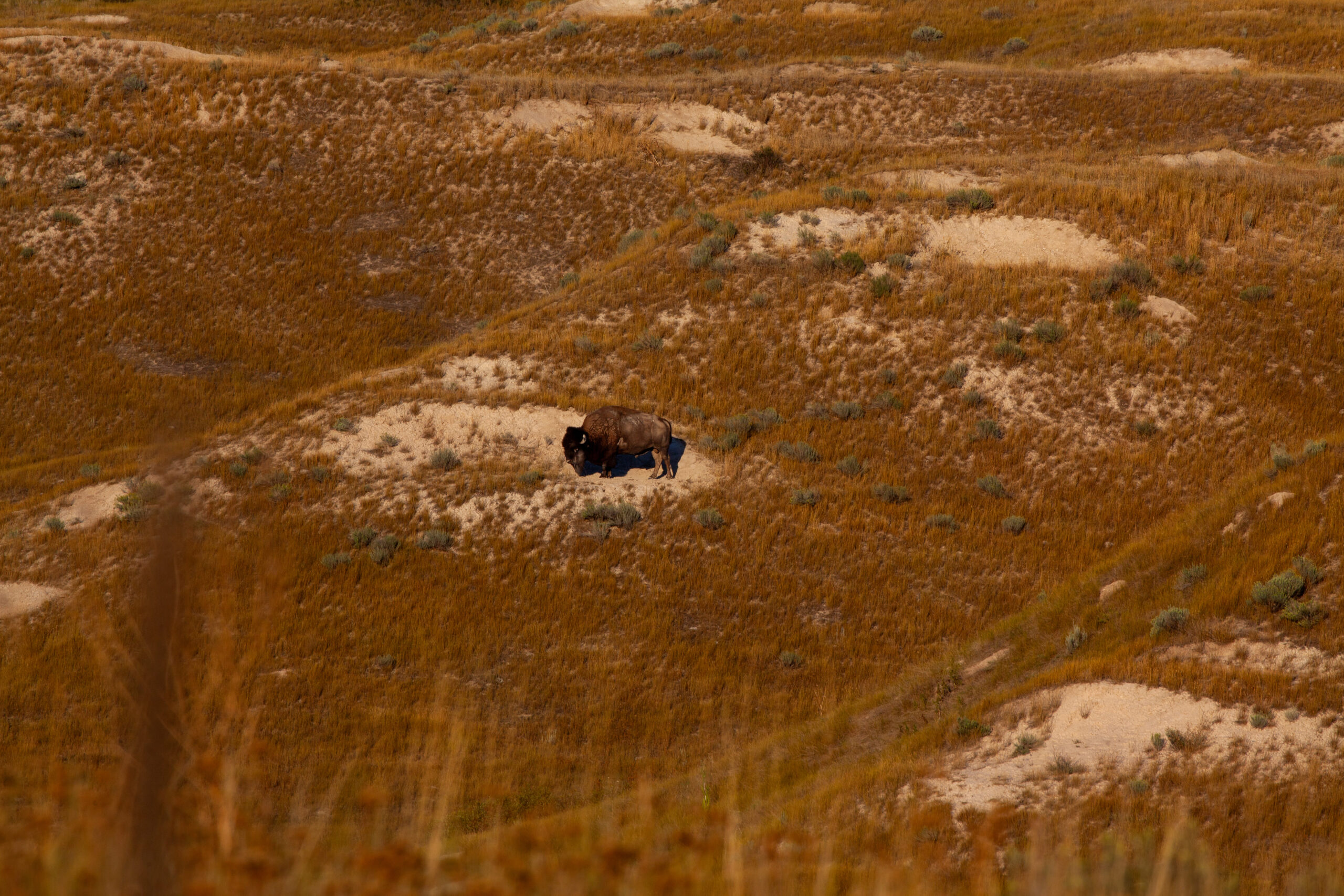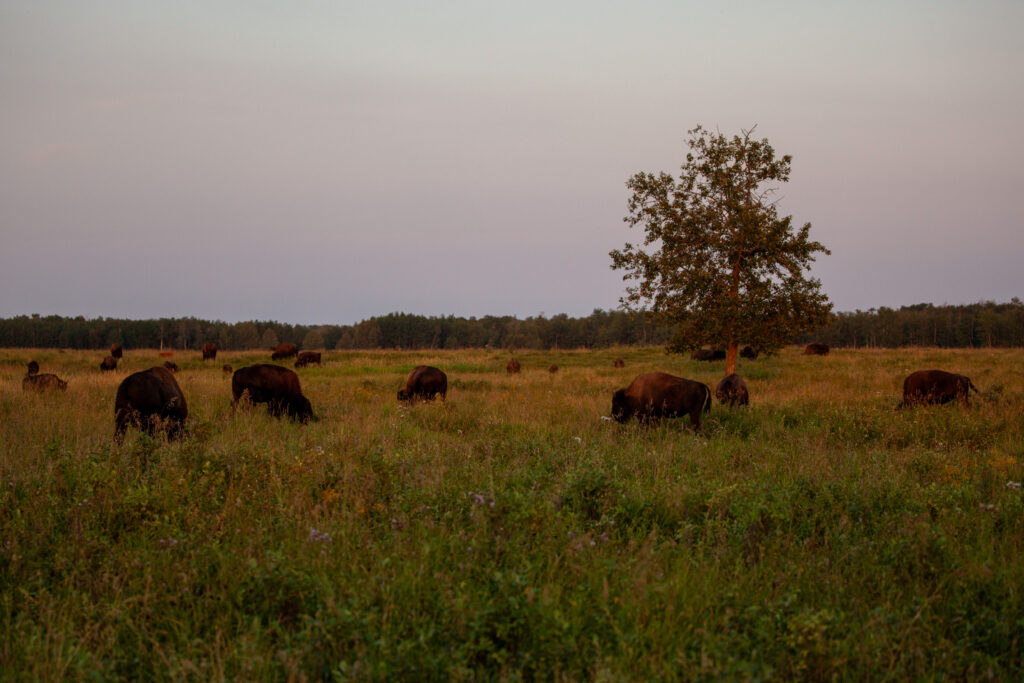
‘Afraid of the water’? Life in a city that dumps billions of litres of raw sewage into lakes and rivers
10 billion litres of sewage are dumped into Winnipeg’s lakes and rivers each year. Some...
This piece was originally published in the IndigiNews newsletter.
You may have seen that IndigiNews recently published two versions of a story about Buffalo rematriation on the plains — one in English, and one in nêhiyawêwin — in collaboration with our friends at The Narwhal.
This project has been a highlight of the past year (and ever!) at IndigiNews, and I wanted to give a bit more context about how it all came together.
It was back in the summertime when I got a call from Narwhal editor Michelle Cyca: She wanted to team up with IndigiNews on a story about Buffalo. The idea was amazing — to send Métis writer and photographer Kayla MacInnis on a road trip to visit sites where Buffalo populations are being restored.
“It’s really been a dream to do a big beautiful story about Buffalo and their significance on our homelands,” Michelle said.
“Just a really hopeful story about how we are seeing Buffalo return and what it means for the land and the people. So it felt just really special to see this story come together.”
Over eight days in August, Kayla travelled across the prairies, conducting interviews and photographing Buffalo. The trip resulted in a sprawling feature that IndigiNews and the Narwhal co-published in October.
“At the end of the day this felt different than the stories I’m used to writing,” Kayla explained.
“It was a collective effort that highlighted something that matters so much to our community.”
Originally, we wanted to publish two versions of the piece at the same time: one in English, and one in nêhiyawêwin. We knew that since the story was about revitalization, that utilizing the language of the land it was reported from only felt right.

In an ideal world, every story we publish would be shared in the original language of the place it came from. But bringing Indigenous languages that have been deliberately extinguished back into use takes effort, time and cost. And in the end, we needed to take extra time to allow the process to unfold.
After Cree language holder Dorothy Thunder translated the text of the story, IndigiNews publisher Eden Fineday travelled to amiskwaciywâskahikan (Edmonton) where Dorothy is based, and spent an entire day recording her narrating the piece.
“It was such a privilege to spend time with a Cree language speaker, and Dorothy was so gracious and kind,” Eden said.
“It took a lot of work for her to do that, like a lot of energy for her to read that whole story. Most sentences had to be read two or three times.”
Eden, who herself has been on a journey to learn nêhiyawêwin, spent many hours editing the audio featured in the story. She said she couldn’t help but think about all the generations before who had to fight to hold on to their Indigenous languages, “and now it’s our job to fight to learn them.”
“That’s why I think this Buffalo story is so special because it’s just given us this opportunity,” she said.
“It’s bringing something that most people might consider old; and it’s actually become new.”
After all, we weren’t just highlighting sources who came from a culture of Buffalo and nêhiyawêwin. The entire editorial team who worked on this piece — from the writer, to the editors, to the publisher and translator — come from that culture, too. Each one of us are Cree and/or Métis from the prairies, and hold nêhiyawêwin as an ancestral language.
Creating a version of this story in nêhiyawêwin is about more than just accessibility of the language. It’s about full-circle storytelling. Whenever someone is telling a story from their own culture and lands, something very special happens — and to have an entire team who have this connection was transformational.
“It’s probably the only collaboration like this, honestly, where four people in journalism who all have this ancestral language have collaborated to bring a story like this to life,” Michelle said.
“It feels incredible and really significant.”

I feel so lucky to work with a team of women who deeply understand the dimensions of this subject; after all, the language is deeply linked to the land, which is linked to the Buffalo, which are linked to the people and on and on.
“I feel like we honoured our ancestors and the land and these Indigenous futures and histories,” Kayla said, “because time is not linear and it all exists at once, and it felt like the story was all past and present and future in one.”
It took us until just a few days ago to bring the nêhiyawêwin story into the world, and it definitely felt different than any other story.
When I first heard the recording of Dorothy speaking the story in Cree, and saw the words between Kayla’s stunning photos of the Buffalo, I felt so many emotions well up inside me. It turns out that Kayla, Michelle and Eden all had the same experience, too.
“Scrolling through the story while listening to Dorothy’s voice is a really special experience,” Michelle said.
“I hope that people — even if they don’t know any Cree at all — will take the time just to listen to it and connect to the story on that level. Hear the language that the Buffalo were hearing hundreds of years ago when they were moving across the plains.”
We’ve all felt the magic of this story, cried happy tears, poured love and care into it — and we hope that our readers will feel that, too.
“I also think it’s a really powerful example of what happens when you give Indigenous women editorial control,” Eden said.
“It’s an amazing example of collaboration and just a beautiful experience of reciprocity. This story has given us the opportunity to practice our cultural values around kinship and reciprocity and I’m grateful for that.”
Get the inside scoop on The Narwhal’s environment and climate reporting by signing up for our free newsletter. On a warm September evening nearly 15...
Continue reading
10 billion litres of sewage are dumped into Winnipeg’s lakes and rivers each year. Some...

Court sides with Xatśūll First Nation, temporarily halting Mount Polley mine waste expansion

Break out the champagne: Emma’s storied life and leadership in journalism has earned her the...
